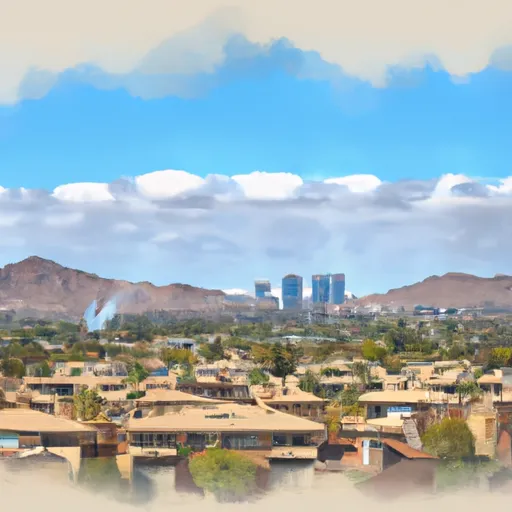-
 Snoflo Premium
Snoflo Premium
Get unlimited access to all our content
With no Ad interruptions! - Start Your Free Trial Login with existing account
Sun-Lakes
Eden Index
Climate
7.8
•
Recreation
4.2
•
Community
6.1
•
Safeguard
6.1/10

Sun Lakes, Arizona is a vibrant community located in Maricopa County, just south of Chandler. Known for its warm and sunny climate, Sun Lakes offers residents and visitors an enjoyable outdoor experience throughout the year. The region has a desert climate, with scorching summers and mild winters. Summers often see temperatures reaching over 100°F, while winter temperatures average in the 60s°F.
Hydrologically, Sun Lakes is situated near the Gila River and lies within the Arizona Water Management Area. The area is supplied with water from the Central Arizona Project, ensuring a reliable water source for residents and recreational activities. The lakes in Sun Lakes, including Sun Lake, Cottonwood Lake, and others, provide opportunities for fishing, boating, and water sports.
Outdoor enthusiasts can explore the numerous golf courses and hiking trails that dot the landscape. The nearby South Mountain Park offers over 50 miles of trails, ideal for hiking, mountain biking, and horseback riding. The Sonoran Desert surrounding Sun Lakes is rich in wildlife, including desert flora, native birds, and coyotes. The community also boasts various sports facilities, tennis courts, and swimming pools, ensuring residents have ample opportunities to stay active and enjoy the outdoor recreation opportunities Sun Lakes has to offer.
What is the Eden Index?
The Snoflo Eden Index serves as a comprehensive rating system for regions, evaluating their desirability through a holistic assessment of climate health, outdoor recreation opportunities, and natural disaster risk, acknowledging the profound impact of these factors on livability and well-being.
Climate Health Indicator (CHI): 7.8
Sun-Lakes receives approximately
199mm of rain per year,
with humidity levels near 46%
and air temperatures averaging around
22°C.
Sun-Lakes has a plant hardyness factor of
9, meaning
plants and agriculture in this region tend to thrive here all year round.
By considering the ideal temperature range, reliable water supplies, clean air, and stable seasonal rain or snowpacks, the Climate Health Indicator (CHI) underscores the significance of a healthy climate as the foundation for quality living.
A healthy climate is paramount for ensuring a high quality of life and livability in a region, fostering both physical well-being and environmental harmony. This can be characterized by ideal temperatures, reliable access to water supplies, clean air, and consistent seasonal rain or snowpacks.
Weather Forecast
Streamflow Conditions
Middle Gila
Area Rivers
Middle Gila
Snowpack Depths
Middle Gila
Reservoir Storage Capacity
Middle Gila
Groundwater Levels
Recreational Opportunity Index (ROI): 4.2
The Recreational Opportunity Index (ROI) recognizes the value of outdoor recreational options, such as parks, hiking trails, camping sites, and fishing spots, while acknowledging that climate plays a pivotal role in ensuring the comfort and consistency of these experiences.
Access to outdoor recreational opportunities, encompassing activities such as parks, hiking, camping, and fishing, is crucial for overall well-being, and the climate plays a pivotal role in enabling and enhancing these experiences, ensuring that individuals can engage in nature-based activities comfortably and consistently.
Camping Areas
| Campground | Campsites | Reservations | Toilets | Showers | Elevation |
|---|---|---|---|---|---|
| Box Bar | 20 | 1,519 ft | |||
| Phon D Sutton | 15 | 1,347 ft | |||
| McDowell Mountain | 76 | 1,875 ft |
Nearby Fishing
Nearby Ski Areas
Catastrophe Safeguard Index (CSI):
The Catastrophe Safeguard Index (CSI) recognizes that natural disaster risk, encompassing floods, fires, hurricanes, and tornadoes, can drastically affect safety and the overall appeal of an area.
The level of natural disaster risk in a region significantly affects safety and the overall livability, with climate change amplifying these risks by potentially increasing the frequency and intensity of events like floods, fires, hurricanes, and tornadoes, thereby posing substantial challenges to community resilience and well-being.
Community Resilience Indicator (CRI): 6.1
The Community Resilience Indicator (CRI) recognizes that education, healthcare, and socioeconomics are crucial to the well-being of a region. The CRI acknowledges the profound impact of these elements on residents' overall quality of life. By evaluating educational resources, healthcare accessibility, and economic inclusivity, the index captures the essential aspects that contribute to a thriving community, fostering resident satisfaction, equity, and social cohesion.

